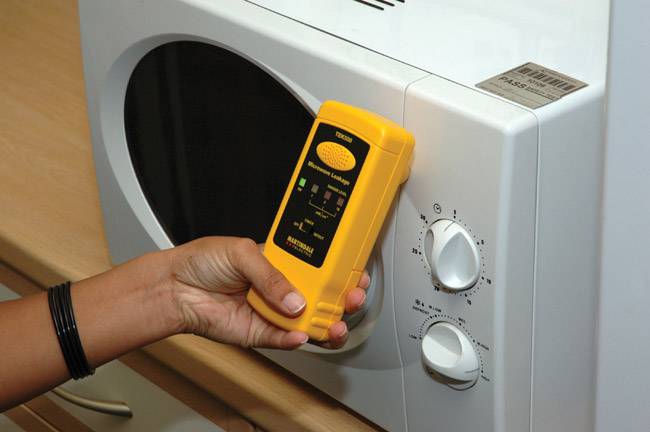If you were in doubt that there is possible microwave radiation in the place where you live or even in your office, you have clicked on the right article. Here you can read everything you need to know regarding how to detect microwave radiation most safely and effectively. So without further ado, let’s begin.

How to Detect Microwave Radiation
As you already know, microwave radiation is not something that anyone would want in a place where they spend most of their time. Although there needs to be much more research done on this topic, from what we can see so far, microwave power and radiation can be quite harmful to people’s and pets’ lives and is something you want to avoid at any cost.
Therefore, to protect yourself and your closest ones from these harmful rays, you will need to learn how to detect microwave radiation and, from there on, how to prevent microwave radiation from happening.
Additionally, as you can not notice or detect microwave radiation, you will need to equip yourself with a microwave radiation tool that will show the accurate percent of possible radiation of this type. One of those devices is the Bolometer, and you can read more about it in the continuation of this article.
How to detect microwave radiation with Bolometer
What is a Bolometer?
A Bolometer is the latest technological finding created by an international research team from Harvard University, POSTECH of South Korea, Barcelona Institute of Science and Technology in Spain, Raytheon BBN Technologies, the National Institute for Materials Science in Japan, and Massachusetts Institute of Technology in the U.S.
This microwave radiation-detecting technology contains ultrasensitive sensors, and thanks to them, the ability to detect microwave radiation is with the highest possible sensitivity, theoretically speaking, of course.
Detecting microwave radiation is essential for implementing it in the newest next-generation quantum communication and quantum computing technologies. And that is where the Bolometer comes into action.
What does the Bolometer measure?
The Bolometer can calculate the total amount of electromagnetic waves that are absorbed by considering and using the changes in the electrical resistance. Thanks to the semiconductor-based diodes in the Bolometer, like gallium arsenide and silicon, the sensitivity of a basic commercial Bolometer that operates at room temperature is usually limited to 1 nanowatt and averages for a second.
How is the Bolometer made?
The most crucial component of which the Bolometer is made out of is graphene. Thanks to the structure of this material, one layer of carbon atoms, and small electronic heat capacity, the graphene can successfully absorb electromagnetic waves without overheating too quickly.
How does the Bolometer work, and how to detect radiation with it?
Simply put, the graphene Bolometer works in a way that converts the incident radiation into heat. Then, thanks to its temperature measuring device, it measures the temperature rise in a suitable sensor to indicate the radiation energy. Thanks to its structure and super-sensitivity, a Bolometer can detect even one single microwave proton, which other much larger radiation detection devices can rarely detect.
Regarding detecting radiation with the Bolometer, you will have to expose the resistive element to microwave power and then apply a DC bias current to the resistor to increase the energy through the Joule heating. After applying this power, there is a change in it that is equal to the absorbed microwave power. This is how you determine microwave radiation.
Also read: Induction Cooking Health Hazards
How to detect microwave radiation using the EMF detector
Another way you can detect microwave radiation is by using the EMF detector device. As there are many variances of this device, you will need to ensure that the particular type of EMF you plan on getting is the right to detect microwave radiation before getting one.
Moreover, because the EMF detector device may be the most popular tool to measure radiation, you can find it almost everywhere and use it to keep the radiation in your home or another place within safe radiation exposure levels.
What is an EMF detector?
The EMF detector is one of the most popular and utilized tools for accurately determining whether there is microwave radiation in a particular area. The main job of the EMF detector is to find inconsistencies in the electromagnetic field, which might lead us to see the possible signs of improper wiring or electrical issues.
What does the EMF detector measure?
The EMF detector is created to measure the electromagnetic field and radiation in a specific area. By utilizing the EMF detector, we can get a precise measurement of the electromagnetic waves and any possible disturbances, such as present microwave radiation, in a room or larger space, depending on the power and type of the EMF detector itself.
Read More: Best EMF Detector Apps for Detecting Radiation

How to detect microwave radiation with an EMF detector, and how does it work?
Thanks to the EMF detector’s ability to register and measure the electromagnetic fields around the device or probe, it can differentiate between normal and high levels, meaning it can easily detect microwave radiation.
This device has the power and is created to calibrate itself to its surroundings, and that is how it detects the harmful microwave radiation present in the given area.
Regarding how to utilize the EMF detector, it is straightforward. All you need to do is turn it on by setting it up to detect microwave radiation. Then, go to where you think there might be this type of radiation and slowly move around. If there is indeed microwave radiation, you will see the numbers on the EMF detector changing.
Conclusion
In this article, we have covered all you need to know to learn how to detect microwave radiation using the two most accurate and popular microwave detection devices. We made sure to include in-depth details on each of the microwave radiation detectors so that the next time you need to do the measuring, you will know exactly which device to choose, what to expect, and most importantly, how to use it.
